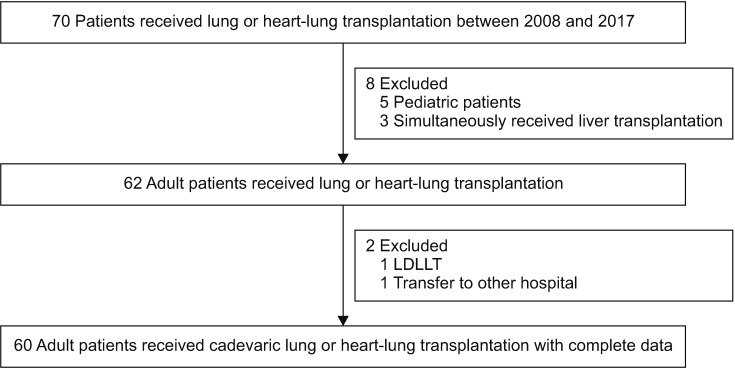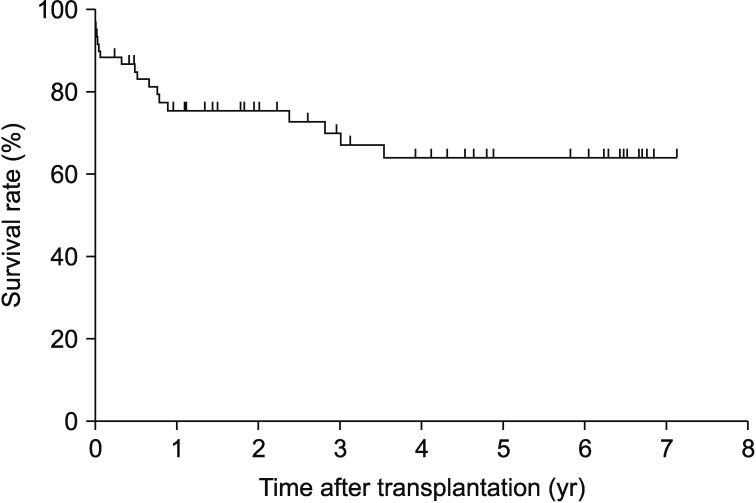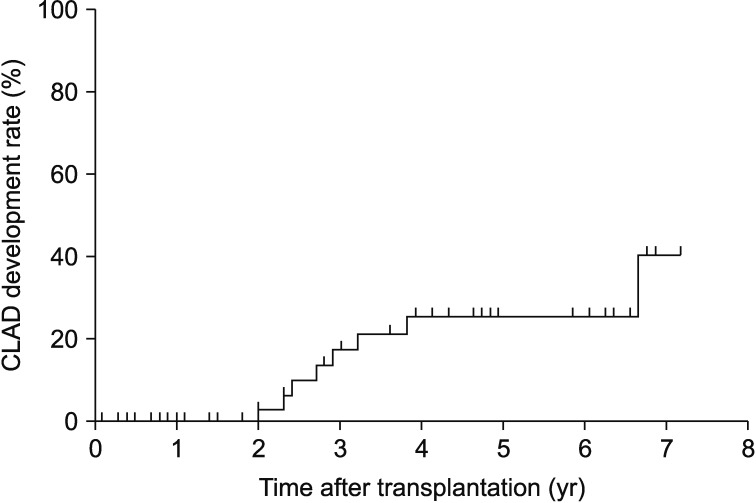Tuberc Respir Dis.
2019 Oct;82(4):348-356. 10.4046/trd.2019.0016.
Long-Term Outcomes of Adult Lung Transplantation Recipients: A Single-Center Experience in South Korea
- Affiliations
-
- 1Division of Pulmonology and Critical Care Medicine, Asan Medical Center, University of Ulsan College of Medicine, Seoul, Korea. shimts@amc.seoul.kr
- 2Department of Thoracic and Cardiovascular Surgery, Asan Medical Center, University of Ulsan College of Medicine, Seoul, Korea. sipark@amc.seoul.kr
- 3Department of Infectious Diseases, Asan Medical Center, University of Ulsan College of Medicine, Seoul, Korea.
- 4Department of Radiology, Asan Medical Center, University of Ulsan College of Medicine, Seoul, Korea.
- 5Department of Anesthesiology and Pain Medicine, Asan Medical Center, University of Ulsan College of Medicine, Seoul, Korea.
- 6Organ Transplantation Center, Asan Medical Center, Seoul, Korea.
- KMID: 2459060
- DOI: http://doi.org/10.4046/trd.2019.0016
Abstract
- BACKGROUND
Recently, the number of lung transplants in South Korea has increased. However, the long-term outcome data is limited. In this study, we aimed to investigate the long-term outcomes of adult lung transplantation recipients.
METHODS
Among the patients that underwent lung transplantation at a tertiary referral center in South Korea between 2008 and 2017, adults patient who underwent deceased-donor lung transplantation with available follow-up data were enrolled. Their medical records were retrospectively reviewed.
RESULTS
Through eligibility screening, we identified 60 adult patients that underwent lung (n=51) or heart-lung transplantation (n=9) during the observation period. Idiopathic pulmonary fibrosis (46.7%, 28/60) was the most frequent cause of lung transplantation. For all the 60 patients, the median follow-up duration for post-transplantation was 2.6 years (range, 0.01-7.6). During the post-transplantation follow-up period, 19 patients (31.7%) died at a median duration of 194 days. The survival rates were 75.5%, 67.6%, and 61.8% at 1 year, 3 years, and 5 years, respectively. Out of the 60 patients, 8 (13.3%) were diagnosed with chronic lung allograft dysfunction (CLAD), after a mean duration of 3.3±2.8 years post-transplantation. The CLAD development rate was 0%, 17.7%, and 25.8% at 1 year, 3 years, and 5 years, respectively. The most common newly developed post-transplantation comorbidity was the chronic kidney disease (CKD; 54.0%), followed by diabetes mellitus (25.9%).
CONCLUSION
Among the adult lung transplantation recipients at a South Korea tertiary referral center, the long-term survival rates were favorable. The proportion of patients who developed CLAD was not substantial. CKD was the most common post-transplantation comorbidity.
MeSH Terms
Figure
Reference
-
1. Rutherford RM, Fisher AJ, Hilton C, Forty J, Hasan A, Gould FK, et al. Functional status and quality of life in patients surviving 10 years after lung transplantation. Am J Transplant. 2005; 5:1099–1104. PMID: 15816892.
Article2. Chambers DC, Yusen RD, Cherikh WS, Goldfarb SB, Kucheryavaya AY, Khusch K, et al. The Registry of the International Society for Heart and Lung Transplantation: Thirty-fourth Adult Lung And Heart-Lung Transplantation Report-2017; Focus Theme: Allograft ischemic time. J Heart Lung Transplant. 2017; 36:1047–1059. PMID: 28784324.
Article3. Morris PJ. Transplantation: a medical miracle of the 20th century. N Engl J Med. 2004; 351:2678–2680. PMID: 15616201.4. Waki K. UNOS Liver Registry: ten year survivals. Clin Transpl. 2006; 29–39. PMID: 18368704.5. Verleden GM, Vos R, Vanaudenaerde B, Dupont L, Yserbyt J, Van Raemdonck D, et al. Current views on chronic rejection after lung transplantation. Transpl Int. 2015; 28:1131–1139. PMID: 25857869.
Article6. Korean Network for Organ Sharing. National data for organ transplantation [Internet]. Seoul: Korean Network for Organ Sharing;2019. cited 2019 May 7. Available from: https://www.konos.go.kr/konosis/index.jsp.7. Cho EN, Haam SJ, Kim SY, Chang YS, Paik HC. Anastomotic airway complications after lung transplantation. Yonsei Med J. 2015; 56:1372–1378. PMID: 26256982.
Article8. Yun JH, Lee SO, Jo KW, Choi SH, Lee J, Chae EJ, et al. Infections after lung transplantation: time of occurrence, sites, and microbiologic etiologies. Korean J Intern Med. 2015; 30:506–514. PMID: 26161017.
Article9. Lee SH, Park MS, Song JH, Kim YS, Lee JG, Paik HC, et al. Perioperative factors associated with 1-year mortality after lung transplantation: a single-center experience in Korea. J Thorac Dis. 2017; 9:4006–4016. PMID: 29268411.
Article10. Jeong YH, Choi S, Park SI, Kim DK. Asan Medical Center Lung Transplantation Team. Clinical outcomes of lung transplantation: experience at Asan Medical Center. Korean J Thorac Cardiovasc Surg. 2018; 51:22–28. PMID: 29430425.
Article11. Verleden GM, Raghu G, Meyer KC, Glanville AR, Corris P. A new classification system for chronic lung allograft dysfunction. J Heart Lung Transplant. 2014; 33:127–133. PMID: 24374027.
Article12. Verleden SE, Ruttens D, Vandermeulen E, Bellon H, Van Raemdonck DE, Dupont LJ, et al. Restrictive chronic lung allograft dysfunction: where are we now? J Heart Lung Transplant. 2015; 34:625–630. PMID: 25577564.
Article13. Vos R, Verleden SE, Verleden GM. Chronic lung allograft dysfunction: evolving practice. Curr Opin Organ Transplant. 2015; 20:483–491. PMID: 26262458.14. Patti MG, Vela MF, Odell DD, Richter JE, Fisichella PM, Vaezi MF. The intersection of GERD, aspiration, and lung transplantation. J Laparoendosc Adv Surg Tech A. 2016; 26:501–505. PMID: 27218671.
Article15. Basseri B, Conklin JL, Pimentel M, Tabrizi R, Phillips EH, Simsir SA, et al. Esophageal motor dysfunction and gastroesophageal reflux are prevalent in lung transplant candidates. Ann Thorac Surg. 2010; 90:1630–1636. PMID: 20971278.
Article16. Vos R, Vanaudenaerde BM, Verleden SE, De Vleeschauwer SI, Willems-Widyastuti A, Van Raemdonck DE, et al. A randomised controlled trial of azithromycin to prevent chronic rejection after lung transplantation. Eur Respir J. 2011; 37:164–172. PMID: 20562124.
Article17. Kim WY, Hong SB. Humidifier disinfectant-associated lung injury: six years after the tragic event. Tuberc Respir Dis. 2017; 80:351–357.
Article18. Korean Network for Organ Sharing. National data for organ transplantation [Internet]. Seoul: Korean Network for Organ Sharing;2019. cited 2019 May 7. Available from: https://www.konos.go.kr/konosis/common/bizlogic.jsp?fwdUrl=/sub4/sub04_06_01_list.jsp&boardid=22&event=search2&svc=web.wm.law.19. Schaffer JM, Singh SK, Reitz BA, Zamanian RT, Mallidi HR. Single- vs double-lung transplantation in patients with chronic obstructive pulmonary disease and idiopathic pulmonary fibrosis since the implementation of lung allocation based on medical need. JAMA. 2015; 313:936–948. PMID: 25734735.
Article20. Puri V, Patterson GA, Meyers BF. Single versus bilateral lung transplantation: do guidelines exist? Thorac Surg Clin. 2015; 25:47–54. PMID: 25430429.21. George TJ, Arnaoutakis GJ, Beaty CA, Pipeling MR, Merlo CA, Conte JV, et al. Acute kidney injury increases mortality after lung transplantation. Ann Thorac Surg. 2012; 94:185–192. PMID: 22325467.
Article22. Arnaoutakis GJ, George TJ, Robinson CW, Gibbs KW, Orens JB, Merlo CA, et al. Severe acute kidney injury according to the RIFLE (risk, injury, failure, loss, end stage) criteria affects mortality in lung transplantation. J Heart Lung Transplant. 2011; 30:1161–1168. PMID: 21620737.
Article23. Jayarajan SN, Taghavi S, Komaroff E, Brann S, Horai T, Cordova F, et al. Impact of extracorporeal membrane oxygenation or mechanical ventilation as bridge to combined heart-lung transplantation on short-term and long-term survival. Transplantation. 2014; 97:111–115. PMID: 24056630.
Article24. Crotti S, Iotti GA, Lissoni A, Belliato M, Zanierato M, Chierichetti M, et al. Organ allocation waiting time during extracorporeal bridge to lung transplant affects outcomes. Chest. 2013; 144:1018–1025. PMID: 23599162.
Article25. Hayanga AJ, Du AL, Joubert K, Tuft M, Baird R, Pilewski J, et al. Mechanical ventilation and extracorporeal membrane oxygenation as a bridging strategy to lung transplantation: significant gains in survival. Am J Transplant. 2018; 18:125–135. PMID: 28695576.
Article26. George TJ, Beaty CA, Kilic A, Shah PD, Merlo CA, Shah AS. Outcomes and temporal trends among high-risk patients after lung transplantation in the United States. J Heart Lung Transplant. 2012; 31:1182–1191. PMID: 22885156.
Article27. Verleden SE, Sacreas A, Vos R, Vanaudenaerde BM, Verleden GM. Advances in understanding bronchiolitis obliterans after lung transplantation. Chest. 2016; 150:219–225. PMID: 27212132.
Article28. Yusen RD, Christie JD, Edwards LB, Kucheryavaya AY, Benden C, Dipchand AI, et al. The Registry of the International Society for Heart and Lung Transplantation: Thirtieth Adult Lung and Heart-Lung Transplant Report, 2013; focus theme: age. J Heart Lung Transplant. 2013; 32:965–978. PMID: 24054805.29. Bloom RD, Doyle AM. Kidney disease after heart and lung transplantation. Am J Transplant. 2006; 6:671–679. PMID: 16539623.
Article30. Floreth T, Bhorade SM, Ahya VN. Conventional and novel approaches to immunosuppression. Clin Chest Med. 2011; 32:265–277. PMID: 21511089.
Article31. Scheffert JL, Raza K. Immunosuppression in lung transplantation. J Thorac Dis. 2014; 6:1039–1053. PMID: 25132971.
- Full Text Links
- Actions
-
Cited
- CITED
-
- Close
- Share
- Similar articles
-
- Split liver transplantation for one adult and one pediatric recipient: A collective review of Korean experience
- Whole liver deceased donor liver transplantation for pediatric recipients: single-center experience for 20 years
- Pediatric heart transplantation: how to manage problems affecting long-term outcomes?
- Surveillance and management of de novo malignancy after liver transplantation
- The 10 Years Experience of Lung Transplantation




